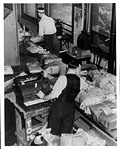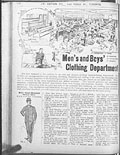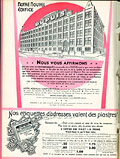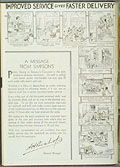|
|
| |
 |
|
| |
 Applying
postage to outgoing parcels, Eaton's Winter Catalogue, 1943. Applying
postage to outgoing parcels, Eaton's Winter Catalogue, 1943.
|
|
| |
|
|
|
Processing Orders in the Mail-order Industry
by John
Willis
The successful operation of a department-store
catalogue business
rested on a large labour force and a sophisticated organization of labour.
Many
hands made light work, and many hands processed a lot of goods.
Introduction | Many Hands Make Light
Work
| The Structure of Mail-order Work | Incoming
Mail | Handling the Money | Reading
the
Orders | Recording the Orders | Copying
the Orders | Money-order Distribution | Assembly
| Money-order Billing | Packing and
Shipping
| Conclusion | Further Reading
|
Introduction
The history of the mail-order catalogue is a story about distribution
on
a massive scale. Railways and the postal service permitted orders to be
processed
through the mail from coast to coast. Distribution was made possible by
the finely
tuned internal organization of the mail-order companies.
The successful operation of a department-store catalogue business
rested on
a large labour force and a sophisticated organization of labour that
permitted
the distribution of goods to customers from the Atlantic to the Pacific.
The
organization of work in a catalogue processing centre resembled an
industrial
assembly line. This was no accident as this is how all major businesses
were
organized during the late 19th and early 20th centuries.
|
Many Hands Make Light Work
| |
 |
|
| |
 One
big family: Eaton's employees in front of the mail-order building in
Moncton, New Brunswick, ca 1920-21. In 1930, 844 people worked out of
Eaton's Atlantic headquarters in Moncton. One
big family: Eaton's employees in front of the mail-order building in
Moncton, New Brunswick, ca 1920-21. In 1930, 844 people worked out of
Eaton's Atlantic headquarters in Moncton.
|
|
| |
|
|
|
Mail-order companies were capable of handling a large volume of
business in
a short period of time. For example, during the 1930s, the Toronto
Eaton's
mail-order office processed 30 000 transactions per day, and the
Winnipeg
Eaton's office handled an impressive 47 735 orders in one
workday.
In 1931, Dupuis Frères processed 10 000 orders per month over
the
phone. At the same time, Simpson's was equipped with a
state-of-the-art
automatic switchboard system. So many orders and so much work, called for
many
hands, a veritable army of employees.
| |
 |
|
| |
 Eaton's
men's and boy's clothing department as depicted in the Eaton's Fall/Winter
Catalogue, 1899-1900, p. 118. Eaton's
men's and boy's clothing department as depicted in the Eaton's Fall/Winter
Catalogue, 1899-1900, p. 118.
|
|
| |
|
|
|
In 1910 Toronto, 500 people worked in the mail-order division of the T.
Eaton
Co. The number rose to roughly 1100 by the 1930s. The mail-order staff was
part
of a labour force of 12 000 to 13 000 people working mainly out
of
the beehive of Eaton's stores, warehouses, and factories at the
Queen Street
location in downtown Toronto. At the regional headquarters in Moncton,
most of
the 844 Eaton's employees worked in mail order. Meanwhile, in
Winnipeg,
more than 1000 employees worked for Eaton's mail order during the
early
1930s. Hundreds more worked in the store and factories.
Eaton's operated on a grand scale, with its large facilities in
Toronto,
Winnipeg, and Moncton. Although no less active in the East (in Halifax)
and West
(Regina), the Simpson's mail-order operation in Toronto was a
relatively
smaller affair, employing 350 to 500 people during the early 1930s. Dupuis
Frères
of Montréal employed a work force similar in scale to
Simpson's
of Toronto. Three hundred people - the vast majority women -
worked
in mail order in 1930. The number fell to 170 four years later, a decline
indicative
of the devastating impact of the Great Depression.
| |
 |
|
| |
 New
mail-order building, home to 200 to 300 employees in southwest
Montréal
(Saint-Henri). The building was conveniently located close to at least
two railway stations. Dupuis Frères, Fall/Winter Catalogue,
1936-37. New
mail-order building, home to 200 to 300 employees in southwest
Montréal
(Saint-Henri). The building was conveniently located close to at least
two railway stations. Dupuis Frères, Fall/Winter Catalogue,
1936-37.
|
|
| |
|
|
|
Mail-order buildings were industrial in scale and function. Dupuis
Frères
ran its comptoir postal out of a five-storey building occupying a
space
of 12.5 square metres [135 000 square feet]. Completed in 1916,
Simpson's
Mutual Street facility in Toronto was eleven stories high. The two
Eaton's
mail-order buildings in Winnipeg were eight and nine stories. An adjacent
power
plant generated electricity for lighting purposes and helped power the 2.4
kilometres
[one-and-a-half miles] of conveyor belts that moved parcels throughout the
mail-order
and retailing complex.
The use of conveyor belts was a standard form of industrial technology
during
the first half of the 20th century, as common in mail-order buildings as
in food
processing plants and large urban post offices. Another common feature of
these
now archaic industrial interiors was the freight elevator with large
wooden doors.
Employees at Dupuis Frères were instructed not to use the freight
elevator.
They were supposed to walk the length of the building and use the
passenger elevators
instead.
| |
 |
|
| |
 Mail-order
employees and conveyor belts at Eaton's of Toronto, 1919. Mail-order
employees and conveyor belts at Eaton's of Toronto, 1919.
|
|
| |
|
|
|
By today's standards, technology in the mail-order
"factory"
was rudimentary. The outstanding feature was the combination of modern
devices
such as conveyor belts, elevators, and telephones with areas of work where
human
bone and sinew provided the necessary motive power.
|
The Structure of Mail-order Work
| |
 |
|
| |
 Eight
different tasks associated with the processing of a mail-order order
as promoted in Simpson's Fall/Winter Catalogue, 1930-31, p. 2. Eight
different tasks associated with the processing of a mail-order order
as promoted in Simpson's Fall/Winter Catalogue, 1930-31, p. 2.
|
|
| |
|
|
|
Conveyor belts and elbow grease were the cornerstones of mail-order
work in
the early 20th century. The two elements were integrated into a common
organization
of labour. The work was divided into many individual tasks, each employee
repeating
his or her task day after day. In a sense, this minimized the incidence of
mistakes,
for each person rarely encountered an unfamiliar work situation. Overall,
the
result was a higher flow of orders throughout the system. More orders
meant more
money.
In 1896, Eaton's sent its mail-order manager, Fred Beechcroft, to
study
the mail-order system of Montgomery Ward, an American company with 20
years'
experience in the field. The company then implemented a system consisting
of
ten or so major steps, which, for the next three decades, characterized
order
processing at Eaton's, and probably elsewhere in Canada. We will
look at
each of these steps one by one using information from the 1920s in the
Eaton's
Collection of the Archives of Ontario.
|
Incoming Mail
| |
 |
|
| |
 Opening
mail at Eaton's (Winnipeg), ca 1910. Towards the rear of the photo, a
woman is exiting from a caged area. This is where the money was counted.
Number 24 in a series of commemorative cards issued by Eaton's. Opening
mail at Eaton's (Winnipeg), ca 1910. Towards the rear of the photo, a
woman is exiting from a caged area. This is where the money was counted.
Number 24 in a series of commemorative cards issued by Eaton's.
|
|
| |
|
|
|
Each day, Eaton's personnel were sent down Yonge Street to fetch
the
mail from the postal terminal at Union Station or, in some situations, off
the
trains. Five trips were made per day. Ninety per cent of the mail arrived
during
the first two deliveries, which meant that by mid-morning a huge pile
loomed
for Eaton's staff.
Mail was separated into business and personal piles. Business mail was
sorted
into packages of 50 letters, which were put through the "Lightning
Letter
Opener Machine." Six women opened and sorted the mail according to
contents,
i.e., letters with or without money, and letters in English or French. The
final
task was to affix a shipping bill to the order.
|
Handling the Money
Customers frequently sent cash with their orders. Due to security
concerns,
counting was conducted in an area cordoned off in
"authorizing" cages.
The money was counted by electric adding machines, which were locked and
unlocked
by supervisors who hovered over the workers. The staff in the cages
checked the
shipping bills and money statements printed out on the machines. The money
collected
was prepared for shipment to the bank. Deposits were made three times a
day.
|
Reading the Orders
Orders left the authorizing cage for the Reading Section, where they
were
assigned different itineraries. English and French orders were separated;
the
latter were sent to the translator's desk. Orders for a large number
of
goods (heavy multiples) were separated from those to be delivered by post.
Requests
for samples were handled at this point. A team of women picked up the
paperwork
and took it to its next destination.
| |
 |
|
Women at their desks in the
Eaton's (Toronto) mail-order department in Toronto, 1943.
|
 |
|
|
Recording the Orders
Staff in this section made labels using the shipping bill number,
date, and
amount of money. The customer's address was typed onto the shipping
bill
using a stencil machine. If the order was from a new customer, the
information
was sent to a "new-name girl," who cut a new stencil. In the
event
the customer resided in an unsettled district, the address was made out to
the
nearest post office. The order now consisted of an addressed shipping bill
and
as many shipping labels as there were packages to ship.
|
Copying the Orders
Time was of the essence. Each copier had upper and lower compartments
on her
desk. The most recent orders went on top. The copier took the first order
from
the lower compartment. She copied each item from the customer order onto
separate
departmental order sheets. Two or more items from the same department
might go
on the same sheet, if they appeared close enough to one another on the
list,
and if the copier could take the time to do this. Copiers were credited
the orders
they completed. This information was sent to the wages office as the basis
for
bonuses to be paid out.
| |
 |
|
Copying section at Eaton's
as represented in one of a series of commemorative cards. On the reverse
side of the card it reads: "When the mail openers have opened the letters,
and the cashiers have taken off the money, the young lady receiving your
letter carefully reads it and makes abstracts on the order sheet for
goods from each department. Every hour these orders are sent to the proper
department."
|
 |
|
|
Money-order Distribution
The Distribution department received orders and papers from Copying,
and
counted and sorted them according to the eventual means of transport:
parcel
post, express, or freight. The orders were stamped with a time that was
three
hours ahead of the moment the goods were expected to reach the Assembly
department.
It took 80 minutes to stamp, check, list, and deliver orders to the
various
merchandise departments. Staff then had an hour and 40 minutes to get the
goods
to Assembly within the time limit. Particular care was taken to ensure
that the
correct list of goods was addressed to the correct department. Sales
listers
and checkers worked in pairs, two pairs of eyes being better than one. All
the
work was punctuated by intervals of 20 minutes. The ringing of the buzzer
in
one department signalled that there was more work for the staff next in
line.
|
Assembly
The order sheets went to the individual merchandise departments and
the shipping
bills went to Assembly, a crucial step in the mail-order process. The
Assembly
area, known in mail-order parlance as "the junction,"
consisted of
conveyor belts, which moved goods to various stations, and a series of
storage
bunks for each of the three main means of conveyance: parcel post,
express, and
freight.
| |
 |
|
| |
 Men
and Women at a conveyor belt with packages, 1948. Men
and Women at a conveyor belt with packages, 1948.
|
|
| |
|
|
|
Workers responsible for taking goods off the belts were known as
pickers.
They sorted goods according to the schedule stamp on the accompanying
sheet.
The storage bunks took up a lot of space: Express had three units of 10
bunks,
parcel post three units of 18 bunks and three units of 36 bunks, and
freight
three units of 6 bunks. Once the order was completed (an average of 20
minutes),
the shipping bill was sent to the Billing section. The goods were sent to
Packing
and Shipping.
|
Money-order Billing
In the Billing section, the list of goods and amounts charged to the
customer
was checked for the last time. Each "biller" made sure that
the customer
was not charged too much or too little for the order. Parcel post packages
were
weighed and amounts due by or to the customer verified using
"mechanical
accountants," i.e., by machine. Both staff and management personnel
were
trouble-shooters. An efficiency penalty of five cents was charged to the
Recording
section for each wrong address and a bonus of ten cents was paid for
errors discovered
in work done by the Copying section. The bonus system kept everyone on
their
toes.
|
Packing and Shipping
Goods received from Assembly were wrapped, labelled, and tied with
string
before being sent to the Shipping department. At the Eaton's Moncton
office,
packers handled 24 heavy orders, 30 light post orders, or 12 regular
express
parcels per hour. Men handled freight and express packing, women parcel
post
packing.
The Shipping department conveyed parcels to the appropriate means of
transport:
truck, train, postal service. Mail-order companies relied on their own
fleets
of horse-drawn and later motor-powered vehicles to deliver goods to city
customers
nearby. Otherwise, it was up to the post office, express company, or
railway
to deliver the goods.
|
Conclusion
| |
 |
|
| |
 Cover
of the Dupuis Frères newsletter (Le Duprex), October
1927. Cover
of the Dupuis Frères newsletter (Le Duprex), October
1927.
|
|
| |
|
|
|
The mail-order factory was a substantial premises and involved a
complex operation.
A single customer order was destined to pass through dozens of pairs of
hands.
The organization of work was specific, precise and timed, right to the
minute.
But, what held the entire operation together? What gave employees the
necessary
morale to come in day after day? The opportunity to earn a living was one
motivation,
but more was at stake. Work was certainly enlivened on occasion by
on-the-job
socializing. The games room, adjacent to the cafeteria of the Dupuis
Frères
comptoir postal, was a good place to make friends. The cloakroom
was
another. Then there were the company newsletters, softball, bowling and
hockey
leagues, summer camps, the annual Saint-Jean-Baptiste day parade in
Montréal,
and the Santa Claus parade in Toronto. In effect, company-sponsored
leisure and
on-the-job social exchange between employees made for a sustainable work
environment.
Then, as now, no place of work is complete without the human touch.
| |
 |
|
| |
 Simpson's
mail-order department picnic at High Park, Toronto, July 15, 1933. Simpson's
mail-order department picnic at High Park, Toronto, July 15, 1933.
|
|
| |
|
|
|
|
Further Reading
Anderson, Carol J. "Mail-order Labour: Working in the
Eaton's
Mail-order Department." Unpublished manuscript, Canadian Postal
Museum,
2001.
Archives of Ontario E. Eaton and Co. Fonds, F-229, Series 53, Box 1.
Mail-order
Procedures, "Mail-order Systems: Toronto, 1920-1926" and
"Toronto
and Moncton Systems Compared, 1933."
O'Connor, Eileen. "The Eaton's Mail-order Catalogue,
1884-1976:
An Archival Analysis." Unpublished manuscript, History Division,
Canadian
Museum of Civilization, 1996.
Royal Commission on Price Spreads and Mass Buying. Committee on Price
Spreads.
Proceedings, vol. 3, 1934.
Service des Archives, HEC, Fonds Dupuis Frères PO 40-Z99,0026
(21684
16-02-02), "Instruments et réglements aux membres du
personnel Dupuis
Frères Limitée," Comptoir postal.
|
| |
|
|